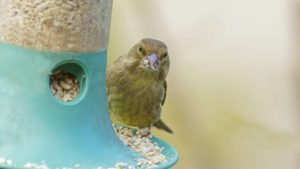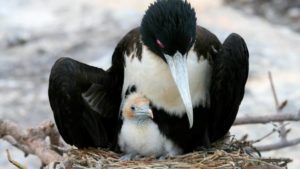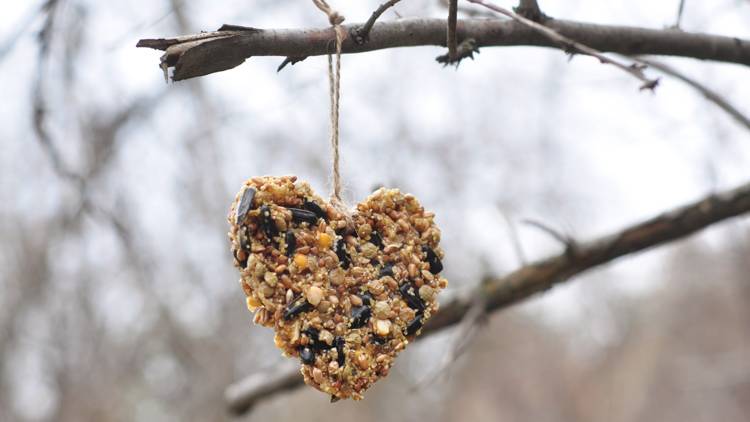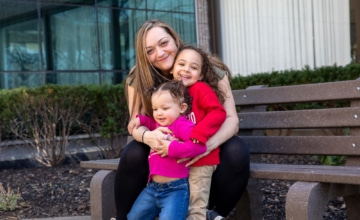Wherever you live, you’ll find birds. And because babies and toddlers are interested in everything that creeps and crawls and flies, they are interested in birds too. Here’s how you can build on that natural curiosity to explore the world with your little one.
Teach caring and responsibility.
Do you live somewhere where the winters are cold? Have an outdoor spot for a bird-feeder? You can demonstrate empathy and kindness by making feeding the birds a part of your winter routine. If you feed the birds regularly, they’ll keep an eye on your yard and appear when the food appears. Put the feeder somewhere where it can be seen from a window and watch mealtime with your baby or toddler from a cozy place inside.
Observe together.
The fascinating behavior of a bird can lead to a conversation about what you’re seeing, what’s happening, and why. (It’s ok if most of the talking comes from you at first. Your child is learning about how conversations work long before they can talk.)

Wonder.
Under-threes are eager to explore the world, and you can encourage them by asking questions of your own. “Look at those birds. Where do you think they’re going?” “Do you see that robin? He’s got a worm. What do you think will happen next?”
Count.
Your toddler is likely to be wildly entertained by a long line of birds flying by and your frantic efforts to count them all. Fortunately, birds often appear by themselves or in pairs, making counting a little easier.
Categorize.
Sorting and classifying–figuring out how things are alike and different–are important early math skills. Your toddler may take a while to figure out the differences between four-legged animals, using “doggie” for everything from leopards to llamas. Birds are easier—they’re the only creatures that have feathers and fly. You can add to your child’s developing vocabulary by identifying common birds and describing what makes one kind different from another. You can talk about the gray color of a pigeon, or the little head-bob that it does when it walks, or the sound it makes when it’s hanging out on your windowsill.
Watching animal activity in the park or playground is a great way to enjoy time with your child. Your enthusiasm for what you find can lead to an interest in and respect for nature that lasts a lifetime.

Want to bring the fun indoors? Try these picture books that feature feathered friends.
For babies and toddlers:
Birds by Kevin Henkes, illustrated by Laura Dronzek. This board book begins with simple text: In the morning, I hear birds singing through the open window. What follows is a colorful, joyful look at birds through a preschooler’s eyes.
Hello World! Birds by Jill MacDonald. Easy-to-understand details and crisp cut-paper illustrations make this engaging for babies and toddlers alike.
Little Owl’s Night by Divya Srinivasan. This charming board book describes all the wonderful things that happen at night while babies sleep.
Owl Babies by Martin Waddell, illustrated by Patrick Benson. A classic board book that gently explores separation anxiety. Three little owls are lonely and afraid when their mother leaves the nest at night, and they happily celebrate her return.
For toddlers and preschoolers:
Bird Builds a Nest: A First Science Storybook by Martin Jenkins. A bird’s activities are described in simple text and lively illustrations: Bird pulls hard, but the worm pulls back.
Have You Heard the Nesting Bird? by Rita Gray, illustrated by Kenard Pak. Birds have lots of different songs, but you’ll not hear a peep from a nesting robin. This rhyming book explains why.
Mama Built a Little Nest by Jennifer Ward, illustrated by Steve Jenkins. Woodpeckers build their nests in holes in trees. Hummingbirds build tiny cup-shaped nests. And some birds lay their eggs in nests that belong to other birds. This book explores all kinds of nests in simple rhymes and bright illustrations.
For adults:
Birds, Nests and Eggs by Mel Boring. There’s too much detail for a toddler read-aloud, but once you start watching birds, you’ll have questions. This one has answers about the nesting habits of 15 species. Suitable for 5- to 9-year-olds (and parents and grandparents).
What It’s Like to Be a Bird by David Allen Sibley. Perfect for parents and grandparents eager to share their love of birds. Kids will love the full-color, mostly life-sized illustrations of birds in action, with enough explanation to satisfy the most avid adult birders.





